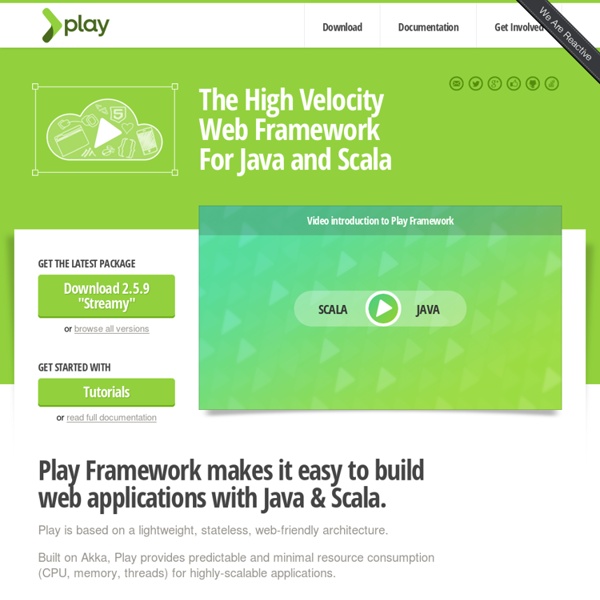



https://www.playframework.com/
Stack: Overview Get Started Now With Typesafe Activator What is a Reactive application? Reactive applications are a new class of applications that are becoming more and more prevalent in both Consumer and Enterprise-facing environments. Reactive applications are fundamentally different to the traditional web-based or mobile applications seen today and are distinguished by having one or more of the following defining traits: Event-Driven: Enables parallel, asynchronous processing of messages or events with ease. Scalable: Can scale within and across nodes elastically to provide compute power on-demand when it’s needed. Buildpacks: Heroku for Everything Last summer, Heroku became a polyglot platform, with official support for Ruby, Node.js, Clojure, Java, Python, and Scala. Building a platform that works equally well for such a wide variety of programming languages was a unique technical design challenge. We knew from the outset that maintaining siloed, language-specific products – a Heroku for Ruby, a Heroku for Node.js, a Heroku for Clojure, and so on – wouldn't be scalable over the long-term. Instead, we created Cedar: a single, general-purpose stack with no native support for any language. Adding support for any language is a matter of layering on a build-time adapter that can compile an app written in a particular language or framework into an executable that can run on the universal runtime provided by Cedar. We call this adapter a buildpack.
Unforgettable: 10 Purple Cow Websites to Spark Your Imagination and Your Creativity On this blog we talk a lot about websites that have effective calls to action, non-cluttered home pages, and trustworthy designs with the intention of showing what techniques help improve conversions. After years of showing our readers examples of what works and what doesn’t, one thing we have noticed is an awful lot of similarity between website designs in the same space. Above: We have your typical “software as a service” (SaaS) website. Look!
JavaScript JavaScript is classified as a prototype-based scripting language with dynamic typing and first-class functions. This mix of features makes it a multi-paradigm language, supporting object-oriented,[6] imperative, and functional[1][7] programming styles. JavaScript has been standardized in the ECMAScript language specification. History[edit] Beginnings at Netscape[edit]
db4o: Simple POJO Persistence We Recommend These Resources Ranging from mobile to web applications, and from plain old Java to Scala or Groovy dialects, a modern Java developer always needs an ace in the hole when it comes to dealing with data persistence. Ideally, you're looking for a solution that gives you enough power to handle your domain complexity while being simple enough to boost your productivity by avoiding painful configurations or steep learning curves. On one side of this scenario you have relational databases with ORM tools which force you to go through several steps like the creation of an object mapping file, a database configuration file, a helper class to initialize a session factory and class association mappings (i.e. precious time spent on downloading, installing, configuring, and then writing a lot of XML). On the other side there's just plain old serialization (mostly ending up in XML files). Using db4o in the Griffon framework
Know Thy User: The Role of Research in Great Interactive Design By David Sherwin - September 30, 2012 At the recent HOW Interactive Design Conference in Washington DC, I gave a presentation called "Know Thy User: The Role of Research in Great Interactive Design." This 30-minute high-level talk was intended to provide conference attendees with repeatable processes that will help them integrate user research into their interactive projects. Other presenters at the conference went more in-depth into some of the methods mentioned in this talk, but I felt that it was important for attendees to understand the role of specific methods and activities within the research process on any design project. When I started working as an user experience designer, I had a thousand questions about how to conduct research. I was lucky to have great mentors and have the chance to collaborate with outside practitioners on a variety of projects.
Cascading Style Sheets CSS is designed primarily to enable the separation of document content from document presentation, including elements such as the layout, colors, and fonts.[1] This separation can improve content accessibility, provide more flexibility and control in the specification of presentation characteristics, enable multiple pages to share formatting, and reduce complexity and repetition in the structural content (such as by allowing for tableless web design). CSS can also allow the same markup page to be presented in different styles for different rendering methods, such as on-screen, in print, by voice (when read out by a speech-based browser or screen reader) and on Braille-based, tactile devices. It can also be used to allow the web page to display differently depending on the screen size or device on which it is being viewed. CSS specifies a priority scheme to determine which style rules apply if more than one rule matches against a particular element. Syntax[edit]
D3.js Is Way More Than Just Another Visualization Framework If you're an experienced web developer, you probably (a) are intimately familiar with the DOM, and (b) still find data-driven JavaScript apps a little unusual. You may know about how Backbone.js has brought MVC architecture to the web -- and if you like data-driven programming, but aren't already using Backbone, you really need to check it out. (And if you're thinking about Backbone but can't quite dive fully into its particular brand of JavaScript MVC: DZone is hoping to publish a Backbone Refcard some time soon, so stay tuned!) But even if you already develop web apps that handle lots of data, you may still think of complex visualization as a thin skin on top of the DOM.
Lightweight Fast Stateless Optimized for resource consumption scalable Reactive Model (Event Driven, non blocking IO) Highly Productive It’s Fun! by yoosoo Mar 20